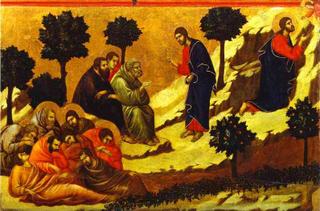 "Let us conclude our reflection with a great witness of the Eastern tradition, Theodoret who was bishop of Cyrus, in Syria, in the fifth century: "The Incarnation of our Savior represents the highest fulfillment of the divine solicitude for men. In fact, neither heaven, nor earth, nor the sea, nor the air, nor the sun, nor the moon, nor the stars, nor the whole visible and invisible universe, created only by his Word or rather brought to the light by his Word, according to his will, indicate his incommensurable goodness as does the fact that the only-begotten Son of God, He who subsisted in the nature of God (see Philippians 2:6), reflection of his glory, mark of his substance (see Hebrews 1:3), who in the beginning was with God and was God, through whom all things were made (see John 1:1-3), after having assumed the nature of a servant, appeared in the form of man, by his human figure was considered as a man, was seen on earth, had relationships with men, bore our infirmities and took our illnesses upon himself" ("Discorsi sulla Provvidenza Divina" [Discourses on Divine Providence], 10: "Collana di Testi Patristici" [Collection of Patristic Texts], LXXV, Rome, 1988, pp. 250-251).
"Let us conclude our reflection with a great witness of the Eastern tradition, Theodoret who was bishop of Cyrus, in Syria, in the fifth century: "The Incarnation of our Savior represents the highest fulfillment of the divine solicitude for men. In fact, neither heaven, nor earth, nor the sea, nor the air, nor the sun, nor the moon, nor the stars, nor the whole visible and invisible universe, created only by his Word or rather brought to the light by his Word, according to his will, indicate his incommensurable goodness as does the fact that the only-begotten Son of God, He who subsisted in the nature of God (see Philippians 2:6), reflection of his glory, mark of his substance (see Hebrews 1:3), who in the beginning was with God and was God, through whom all things were made (see John 1:1-3), after having assumed the nature of a servant, appeared in the form of man, by his human figure was considered as a man, was seen on earth, had relationships with men, bore our infirmities and took our illnesses upon himself" ("Discorsi sulla Provvidenza Divina" [Discourses on Divine Providence], 10: "Collana di Testi Patristici" [Collection of Patristic Texts], LXXV, Rome, 1988, pp. 250-251). "Theodoret of Cyrus continues his reflection, shedding light on the very close relationship underlined by the hymn of the Letter to the Philippians between the incarnation of Jesus and the redemption of men. "The Creator worked for our salvation with wisdom and justice. Because he did not wish to make use only of his power to give us generously the gift of freedom, nor to use only mercy against the one who has subjected the human race, so that he would not accuse mercy of injustice, he devised a way full of love for men and at the same time adorned with justice. In fact, after having united to himself man's vanquished nature, he leads it to the struggle and disposes it to repair the defeat, to rout him who previously had iniquitously won the victory, to free man from the tyranny of which he had been cruelly made a slave and to recover his original freedom" (ibid., pp. 251-252)"
--from the Wednesday audience, 1 June 2005








